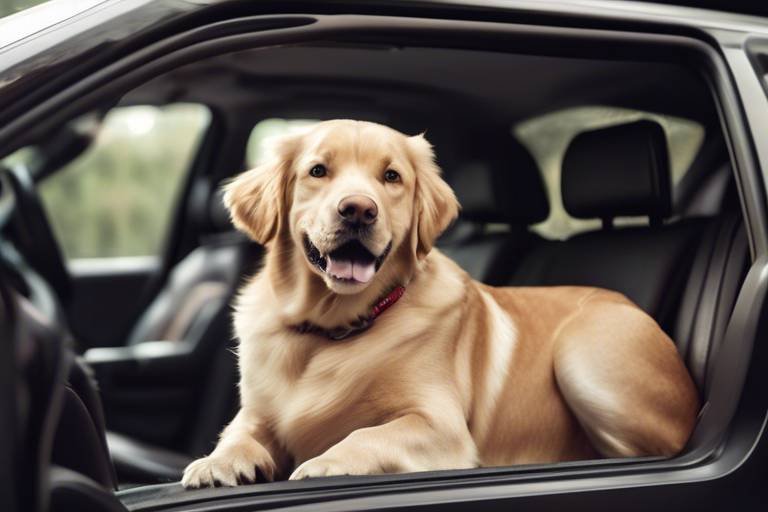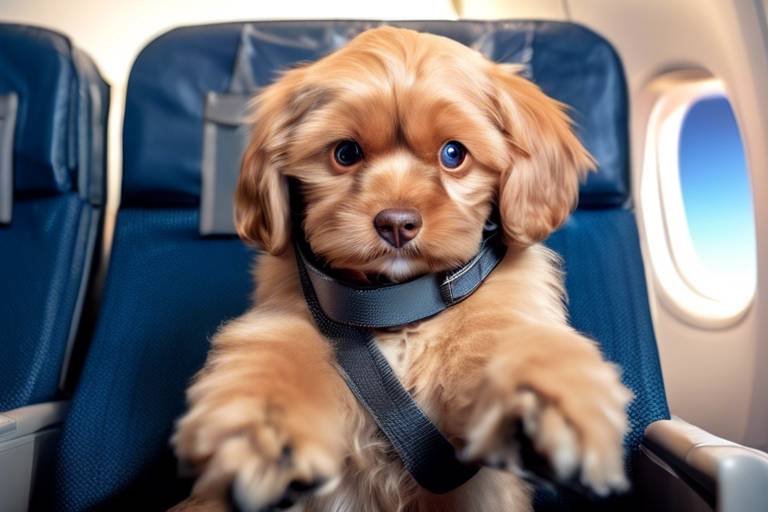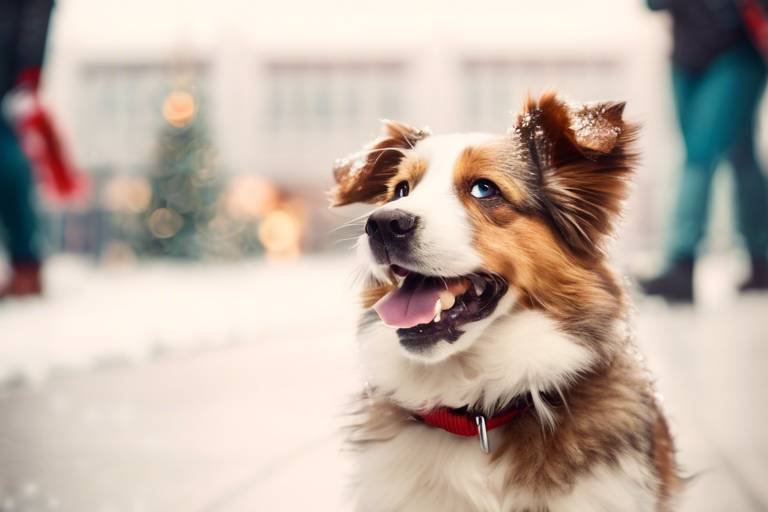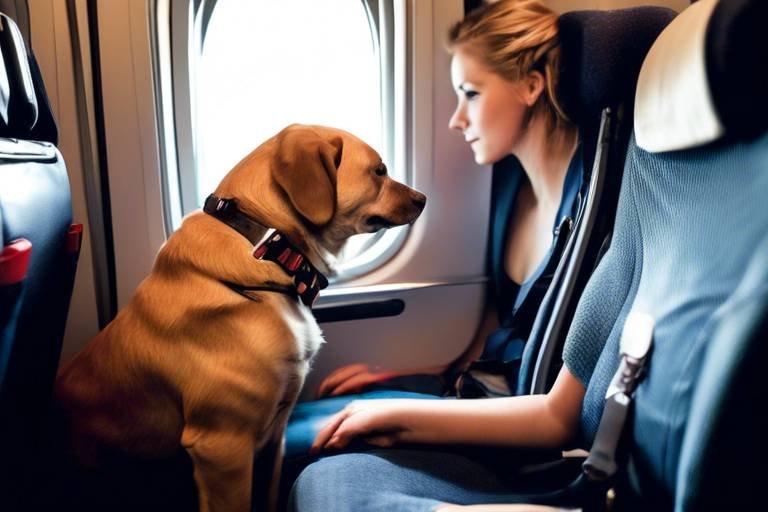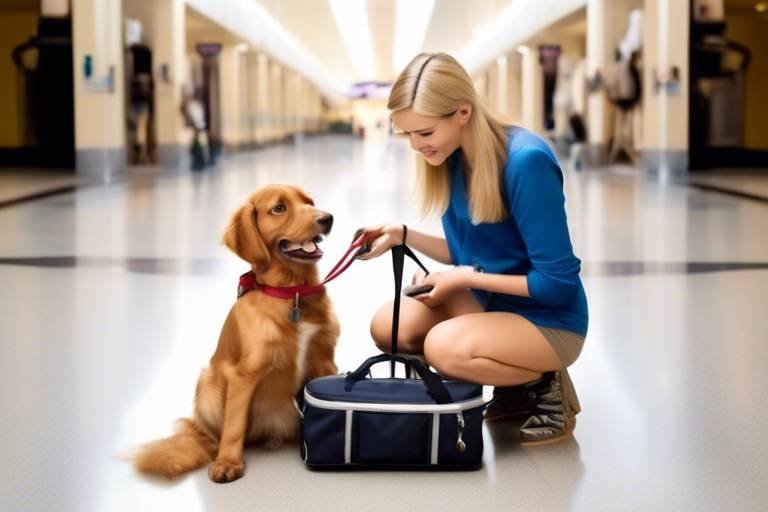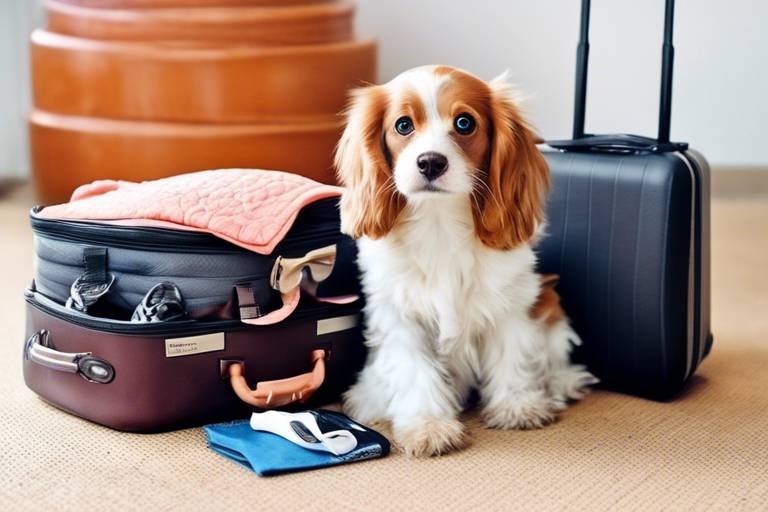Tips for Handling Pets with Special Needs While Traveling
Traveling with pets is often an adventure filled with excitement and joy, but when it comes to animals with special needs, the journey can become a bit more complex. Whether your furry friend has a medical condition, behavioral issues, or specific dietary requirements, understanding how to cater to their needs while on the go is essential for a safe and enjoyable trip. It's like preparing for a treasure hunt; you need to gather all the right tools and information to ensure you find the prize at the end—happy memories with your beloved pet.
Before you pack your bags, take a moment to truly understand your pet's unique requirements. Just like humans, pets can have a variety of needs based on their health, behavior, and personality. For instance, if your pet has a medical condition, you’ll need to consider their medication schedule and any special care they might require. If they have dietary restrictions, planning meals in advance is crucial. Also, don’t overlook behavioral issues; a pet that gets anxious in new environments may need extra comfort items or familiar toys to feel secure. The more you know about your pet's needs, the better equipped you'll be to plan a trip that keeps them happy and healthy.
Proper preparation can significantly ease the travel experience for both you and your pet. Start by gathering all necessary supplies, such as food, water, bowls, leashes, and any medications your pet may require. It’s also wise to schedule a vet appointment before your departure to ensure your pet is healthy enough to travel. Additionally, make sure to update their health records, as some accommodations or travel methods may require proof of vaccination. Think of this preparation as packing a survival kit; the more prepared you are, the smoother your journey will be.
When it comes to traveling with special needs pets, selecting the right mode of transportation is vital. Consider your pet's comfort and safety when choosing between car travel, flying, or using public transport. Each option has its pros and cons, and what works for one pet may not work for another. For instance, some pets may feel more secure in the familiar confines of a car, while others may adapt well to air travel. Always think about how your pet reacts to different environments and choose accordingly.
If you decide to hit the road, ensure your pet is secure in a crate or harness. This not only keeps them safe but also reduces distractions for the driver. Make regular stops for bathroom breaks and exercise; think of it as a mini adventure for both of you! Don't forget to bring along their favorite toys or blankets to provide comfort during the ride. Imagine how a cozy blanket can make a cold night feel warm; similarly, familiar items can help your pet feel at ease on the road.
Flying with a special needs pet? Be sure to check the airline regulations regarding traveling with pets. Some airlines have specific requirements for pets with medical conditions, so it's essential to do your homework. Consider booking direct flights to minimize stress and inform the airline about your pet's requirements in advance. This proactive approach can help ensure a smoother experience, much like having a roadmap for a road trip—it keeps you on track and reduces surprises.
Finding pet-friendly accommodations that cater specifically to special needs is crucial. Not all hotels or rentals are created equal, so take the time to research options that offer accessible amenities. Look for places that have easy access to outdoor spaces, as well as any special accommodations your pet may need. A little research can go a long way in ensuring your pet feels comfortable and safe in their temporary home.
Keeping a consistent routine can help reduce anxiety for pets with special needs. Try to stick to regular feeding times, exercise schedules, and familiar activities throughout the trip. Think of it as maintaining the rhythm of a song; when the beat is consistent, everything flows better. If your pet is used to a specific routine at home, doing your best to replicate that while traveling can help ease their transition and keep them calm.
Being prepared for emergencies is crucial when traveling with special needs pets. Have a plan in place, including a list of nearby veterinarians and emergency contacts, to ensure quick action if needed. This preparation is akin to having a safety net; it gives you peace of mind knowing that help is just around the corner if something goes awry. Make sure to keep this information easily accessible, whether it’s saved on your phone or written down in a travel journal.
After your trip, take the time to monitor your pet for any signs of stress or health issues. Just as we need time to decompress after a busy trip, your pet may need extra attention and care to help them readjust to their home environment. Provide plenty of love, reassurance, and perhaps even some of their favorite treats to help them settle back in. Remember, the goal is to create a positive experience that they will look back on fondly, rather than as a source of stress.
- What should I do if my pet has a medical emergency while traveling?
Always have a list of nearby veterinarians and emergency contacts. If possible, familiarize yourself with the nearest animal hospital before you travel. - Can I bring my pet's medication on the plane?
Yes, but make sure to check airline regulations and keep the medication in its original packaging for easy identification. - How can I help my anxious pet during travel?
Bring familiar items like toys or blankets, maintain a routine, and consider calming supplements if recommended by your vet.

Understanding Your Pet's Special Needs
Traveling with pets can be a delightful adventure, but when your furry friend has special needs, it’s a different ball game. Understanding your pet's unique requirements is not just important; it’s essential for a smooth journey. Think of it this way: just like humans, pets have their own quirks and needs that must be addressed. Whether it’s a medical condition, dietary restriction, or behavioral issue, being informed is your first step towards a worry-free trip.
First and foremost, take the time to consider any medical conditions your pet may have. For instance, if your pet is diabetic, you’ll need to plan for their insulin injections and monitor their blood sugar levels while on the road. Similarly, pets with mobility issues might require special accommodations, such as ramps or wider spaces to move around comfortably. Understanding these needs will help you avoid unnecessary stress during your travels.
Next up, let’s talk about dietary restrictions. Is your pet on a special diet? Maybe they have allergies to certain foods or require a specific type of kibble. It’s crucial to pack enough of their usual food to last the trip, as finding their specific brand in unfamiliar places can be a challenge. You might even want to consider bringing a portable food and water bowl, along with some snacks that are safe for them to munch on during breaks.
Behavioral issues also play a significant role in your pet’s travel experience. Some pets may feel anxious in new environments or around unfamiliar people. If your pet tends to get stressed out, it may be helpful to bring along their favorite toys or blankets to provide comfort. Familiar scents can work wonders in easing anxiety. Additionally, consider speaking with a veterinarian about potential calming aids, like pheromone sprays or anxiety wraps, that can help your pet feel more at ease.
It's also beneficial to keep a record of your pet's health history, including any medications they are currently taking. This not only helps you stay organized but also ensures that you have all the necessary information on hand in case of an emergency. You never know when you might need to share your pet’s medical history with a veterinarian while on the road.
In summary, understanding your pet's special needs is a multi-faceted approach that encompasses their medical conditions, dietary restrictions, and behavioral issues. By taking the time to assess these factors, you can tailor your travel plans to create a safe and enjoyable experience for both you and your beloved pet. Remember, a little preparation goes a long way in ensuring that your adventure is filled with joy rather than stress!

Preparing for Travel
When it comes to traveling with your beloved pet that has special needs, preparation is key. Imagine trying to navigate a maze without a map; that’s what traveling can feel like for both you and your pet if you’re not adequately prepared. Start by gathering all the necessary supplies that cater to your pet's specific needs. For instance, if your pet requires medication, make sure you have enough for the duration of your trip, plus a little extra, just in case. It’s always better to be over-prepared than underprepared!
Additionally, scheduling a vet appointment before you leave is a smart move. This allows you to discuss any concerns you might have about traveling with your pet and get advice tailored to their needs. Don't forget to request a copy of their health records, as many accommodations and airlines require proof of vaccinations and overall health. You wouldn't want to be caught off guard at the last minute!
Another essential aspect of preparation is ensuring your pet is comfortable with their travel environment. If your pet has a favorite blanket or toy, bring it along. Familiar items can provide a sense of security and comfort in unfamiliar surroundings. Also, consider creating a travel kit that includes:
- Food and water bowls
- Leash and harness
- Waste bags
- First-aid supplies
- Any special dietary food
By organizing these items ahead of time, you can avoid the chaos that often accompanies last-minute packing. Think of it as packing a survival kit for your pet; the more prepared you are, the smoother your journey will be.
Lastly, don't forget to check the legality and regulations pertaining to traveling with pets in your destination. Some places have specific rules regarding pet entry, so doing your homework can save you a lot of hassle down the line. Picture this: you’re all set for a fun getaway, only to find out that your furry friend isn’t allowed in certain areas. It’s a buzzkill, right? So, ensure you’re well-informed before you hit the road.
Q: How can I ensure my pet is comfortable during the trip?
A: Bring along their favorite items, maintain a consistent routine, and take regular breaks to stretch their legs.
Q: What should I do if my pet has a medical emergency while traveling?
A: Have a list of nearby veterinary clinics and emergency contacts ready. It's always best to be prepared!
Q: Can I travel by plane with my special needs pet?
A: Yes, but you need to check the airline's specific regulations and inform them of your pet's needs beforehand.
Choosing the Right Travel Method
When it comes to traveling with your special needs pet, selecting the right mode of transportation is absolutely crucial. It's not just about getting from point A to point B; it's about ensuring your furry friend feels safe, comfortable, and secure throughout the journey. Think of it as choosing the perfect vehicle for a road trip—just like you wouldn’t pick a tiny car for a family of five, you shouldn’t choose a travel method that doesn’t suit your pet’s unique needs. So, let’s dive into the different options available and what you should keep in mind for each.
First off, consider the most common travel method: car travel. It’s often the preferred choice for many pet owners because it allows for flexibility and control over the environment. You can stop whenever you need for bathroom breaks or to stretch those little legs. However, make sure that your pet is secured in a crate or a pet seatbelt. Just like a toddler needs a car seat for safety, your pet needs to be restrained to prevent any accidents. Additionally, having their favorite toys or blankets can make the car feel more like home, easing their anxiety during the ride.
Next up, air travel. This can be a bit trickier, especially for pets with special needs. Before booking a flight, check the airline’s regulations regarding pets. Some airlines have specific policies for traveling with special needs animals, and it’s essential to inform them about your pet’s requirements well in advance. If possible, opt for direct flights to minimize the stress of layovers. Remember, flying can be overwhelming for pets due to noise and unfamiliar surroundings, so consider how your pet might react to this environment.
Lastly, public transport can be a viable option, but it often comes with its own set of challenges. Not all buses or trains allow pets, and those that do may have restrictions on size or breed. If you choose this method, ensure you’ve checked the rules beforehand. Also, think about your pet’s temperament—if they’re anxious around strangers or loud noises, public transport might not be the best choice. In any case, it's essential to keep your pet calm and secure, perhaps by using a comfortable carrier or harness.
In summary, the right travel method for your special needs pet is about striking a balance between comfort and practicality. Here’s a quick comparison table to help you visualize the pros and cons:
| Travel Method | Pros | Cons |
|---|---|---|
| Car Travel | Flexible, frequent breaks, familiar environment | Need for secure restraints, potential for motion sickness |
| Air Travel | Fast, long distances covered | Stressful environment, strict regulations |
| Public Transport | Cost-effective, can be convenient | Not always pet-friendly, crowded spaces |
Ultimately, the best travel method depends on your pet’s individual needs and your travel plans. Always prioritize their comfort and safety, and you’ll set the stage for a successful journey together. After all, a happy pet makes for a happy trip!
Car Travel Tips
Traveling by car with your special needs pet can be a rewarding experience, but it also requires careful planning and consideration. First and foremost, ensure your pet's safety during the journey. This means securing them in a crate or using a specialized harness designed for car travel. Just like we buckle up for safety, our furry companions need the same protection to avoid any injuries during sudden stops or turns.
It's essential to take regular breaks during your trip. Pets, especially those with special needs, may require frequent bathroom breaks and opportunities to stretch their legs. Plan your route with this in mind—stop every couple of hours at rest areas where your pet can relieve themselves and enjoy a little exercise. This not only keeps them comfortable but also helps reduce any anxiety they might feel from being confined for too long.
Moreover, bringing along your pet's favorite toys or blankets can provide a sense of familiarity and comfort. Just like a child with a beloved stuffed animal, your pet will appreciate having something that smells like home. If your pet is used to a specific routine, try to maintain that as much as possible. For example, if they usually take a mid-morning nap, find a safe place to pull over and allow them to rest. Consistency can be incredibly soothing for pets with special needs.
Additionally, it’s wise to keep a travel kit handy. This kit should include the following essentials:
- Water and a portable bowl
- Food and any special dietary items
- Medications and health records
- Leash, waste bags, and cleaning supplies
- First aid kit for pets
Lastly, always be aware of the temperature inside the car. If it’s too hot or too cold, it can be dangerous for your pet. Make sure to adjust the climate control accordingly and never leave your pet in a parked car, even for a short time. By keeping these tips in mind, you can ensure a much smoother and enjoyable car trip for both you and your special needs pet.
1. How can I keep my pet calm during a long car ride?
Using calming aids, such as pheromone sprays or anxiety wraps, can help soothe your pet. Additionally, playing soft music or talking to them during the journey can provide comfort.
2. Should I feed my pet before the trip?
It's best to feed your pet a light meal a few hours before departure to avoid motion sickness. During long trips, consider packing snacks that are easy to digest.
3. How often should I stop for breaks?
Aim to stop every 2-3 hours to allow your pet to relieve themselves and stretch their legs. This helps maintain their comfort and reduces stress.
4. What should I do if my pet gets sick during the trip?
If your pet shows signs of distress or sickness, pull over safely and assess the situation. Always have a list of nearby veterinarians handy in case of emergencies.
5. Can I let my pet stick their head out the window?
While it may look cute, it’s unsafe for pets to stick their heads out of the window due to the risk of injury from debris or sudden stops. Keep them safely inside the vehicle.
Air Travel Considerations
Traveling by air with a pet that has special needs can seem daunting, but with the right preparation, it can be a smooth experience for both you and your furry friend. First and foremost, check the airline's regulations regarding pet travel. Each airline has its own set of rules, and understanding these can prevent last-minute surprises at the airport. For example, some airlines only allow pets in the cabin if they meet specific weight and size restrictions, while others might require pets to travel in the cargo hold.
When booking your flight, consider opting for direct flights whenever possible. Layovers can add unnecessary stress to your pet's journey, especially if they have special needs. A direct flight minimizes the time your pet spends in transit and reduces the chances of complications arising during layovers. Don’t forget to inform the airline about your pet’s special requirements when you make your reservation; this way, they can accommodate your needs better.
Before the big day, it’s wise to familiarize your pet with their travel crate. Make it a cozy space by adding their favorite blanket or toy, which can provide comfort during the flight. Additionally, practice short trips in the crate to help them adjust. This can make a world of difference when it comes time to board the plane.
Another crucial aspect is to ensure that your pet is medically fit for travel. Schedule a visit to the veterinarian to discuss your travel plans and get any necessary health certificates, especially if you're flying internationally. Your vet can also advise on whether your pet should take any medications to help ease anxiety during the flight.
Lastly, keep an eye on the weather conditions for the day of travel. Extreme temperatures can affect pets, especially those with special needs. If you’re flying during warmer months, ensure that your pet is well-hydrated and comfortable. Check-in early to allow ample time for security checks and to help your pet adjust to the new environment. By paying attention to these details, you can ensure a safe and enjoyable air travel experience for your special needs pet.
- What documentation do I need for my pet to fly? Most airlines require a health certificate from a veterinarian, especially for international travel. Check with your airline for specific requirements.
- Can my special needs pet travel in the cabin with me? This depends on the airline's policies regarding pet travel. Many airlines allow small pets in the cabin, but you must inform them in advance.
- What should I do if my pet becomes anxious during the flight? Consult your veterinarian for advice on calming medications or techniques that can help soothe your pet during travel.
- How can I ensure my pet's comfort during the flight? Use a familiar crate, provide comfort items, and maintain hydration. Direct flights can also help reduce stress.
Accommodations for Special Needs Pets
Finding the right accommodations for your special needs pet can feel like searching for a needle in a haystack, but it’s absolutely essential for a stress-free trip. Not all pet-friendly places are created equal, and some may not be equipped to handle the unique requirements of pets with special needs. So, what should you look for? First and foremost, consider accessibility. If your pet has mobility issues, check for features like ramps or elevators, as well as room layouts that allow for easy movement.
Another important factor is the environment. A calm and quiet space can make a world of difference for pets that may be anxious or easily stressed. Look for accommodations that are away from noisy areas, such as busy streets or loud pools. Additionally, confirm that the place you choose has policies in place for pets with special needs, such as allowing for extra care or accommodations for medical devices. You wouldn't want to arrive only to find out that your pet’s specific needs can't be met.
Moreover, it’s wise to read reviews from other pet owners who have traveled with similar pets. Their experiences can provide invaluable insights into what to expect. Many websites now have filters for special needs accommodations, making it easier to find the right fit. Consider reaching out directly to the property manager or owner to discuss your pet's specific needs. This way, you can gauge their willingness to accommodate and get a feel for how pet-friendly they truly are.
Here’s a quick checklist to keep in mind when searching for accommodations:
- Accessibility features (ramps, elevators)
- Quiet environment
- Pet policies that cater to special needs
- Reviews from other pet owners
- Direct communication with property management
By taking these steps, you can ensure that your special needs pet has a comfortable and enjoyable stay, allowing you to focus on making wonderful memories together. Remember, the goal is to create a safe haven for your furry friend, so don’t hesitate to ask questions and advocate for their needs!
Q: What should I look for in a pet-friendly hotel?
A: Look for accommodations that have accessibility features, a quiet environment, and clear pet policies that cater to special needs. Reading reviews from other pet owners can also help you gauge if the place is suitable.
Q: How can I ensure my special needs pet is comfortable during our stay?
A: Bring familiar items like their favorite blanket or toy, maintain their routine as much as possible, and communicate with the staff about your pet's specific needs.
Q: Are there any specific questions I should ask when booking accommodations?
A: Yes! Inquire about accessibility features, noise levels, pet policies, and whether they have experience with special needs pets. This will help you find the best fit for your furry friend.

Maintaining Routine While Traveling
When it comes to traveling with pets that have special needs, maintaining a consistent routine is not just a luxury—it's a necessity. Just like humans, pets thrive on familiarity and predictability. Imagine how disorienting it would be to suddenly find yourself in a new environment with a completely different schedule! To help your furry friend feel more at ease during your travels, try to stick to their usual routine as much as possible.
This means keeping to regular feeding times, exercise schedules, and even familiar activities that your pet enjoys. For example, if your dog is used to a morning walk at 8 AM, do your best to replicate that schedule while on the road. You might have to adjust a bit based on travel times, but the key is to keep those essential components of their day intact.
Consider creating a travel schedule that mirrors your pet's usual routine. This could include:
- Feeding times
- Walks and exercise sessions
- Playtime with favorite toys
- Quiet time for relaxation
In addition, bringing along familiar items can greatly help in maintaining this routine. Items like your pet's favorite blanket, toys, or even their bed can provide comfort and a sense of security. The smell of home can be incredibly soothing for your pet, making them feel less stressed in unfamiliar surroundings.
Also, don’t forget to plan for bathroom breaks, especially during long car rides. Stopping every couple of hours not only allows your pet to relieve themselves but also gives them a chance to stretch their legs and explore new smells—an important part of their routine! This can be a great opportunity for you to bond with your pet while ensuring they stay comfortable and happy.
Finally, if your pet has specific behavioral or medical needs, make sure to factor those into your routine as well. For instance, if your pet requires medication at certain times, set reminders on your phone or use a travel pill organizer to keep everything on track. The more you can replicate their normal routine, the more relaxed and content your pet will be during your travels.
Q1: How can I help my pet adjust to a new environment while traveling?
A1: Bringing familiar items, maintaining a consistent routine, and providing plenty of love and attention can help your pet adjust to a new environment.
Q2: What should I do if my pet shows signs of anxiety while traveling?
A2: If your pet seems anxious, try to stick to their routine as much as possible, provide comfort items, and take regular breaks to let them relax and explore.
Q3: Is it necessary to consult a vet before traveling with a special needs pet?
A3: Yes, it's always a good idea to consult your veterinarian before traveling to ensure your pet is fit for travel and to discuss any specific needs or medications.
Emergency Preparedness
When you're on the road with your special needs pet, being prepared for emergencies is more than just a good idea—it's essential. Imagine being in an unfamiliar place and your furry friend suddenly falls ill or has an accident. The last thing you want is to scramble for help. So, let's ensure you're ready for anything that comes your way. First and foremost, create a comprehensive plan before you even hit the road. This plan should include a list of nearby veterinarians, emergency animal hospitals, and pet-friendly accommodations that can cater to your pet’s unique needs. You can use online resources or apps to find these locations quickly.
Additionally, keep a handy emergency kit in your vehicle. This kit should include essential items such as your pet's medical records, medications, a first-aid kit, food and water, and even a favorite toy or blanket that can provide comfort. It's like having a mini survival kit for your pet! You never know when you might need to soothe their nerves or provide quick medical attention. If your pet has specific medical requirements, make sure to have extra supplies on hand, just in case your travel plans change unexpectedly.
Another crucial aspect of emergency preparedness is communicating your pet's needs to those around you. If you're traveling with others, or if you need to seek help from strangers, make sure they understand your pet’s special needs. For instance, if your pet is on a special diet, explain that they can’t eat just anything. If they have behavioral issues, inform others so they can interact appropriately. It's all about ensuring everyone is on the same page to minimize stress for both you and your pet.
Lastly, consider having a pet emergency contact who is familiar with your pet's needs and can step in if something goes wrong while you're away. This could be a trusted friend or family member who knows how to handle your pet's unique requirements. By having this support system in place, you can travel with peace of mind, knowing that your furry companion is in good hands, even if you’re not there.
- What should I include in my pet's emergency kit? Your pet's emergency kit should include medical records, medications, a first-aid kit, food, water, and comfort items like toys or blankets.
- How can I find a veterinarian while traveling? Use online resources, apps, or local directories to locate veterinarians or emergency animal hospitals near your location.
- What if my pet has a medical emergency while traveling? Stay calm, follow your emergency plan, and seek help from the nearest veterinarian or emergency animal hospital immediately.
Post-Travel Care
After an adventure-filled journey, it’s essential to focus on your pet's well-being. Just like us, pets can feel the effects of travel, and they may need a little extra love and care to bounce back. One of the first things you should do is monitor your pet closely for any signs of stress or health issues. This can include changes in appetite, lethargy, or unusual behavior. If your furry friend seems off, don’t hesitate to reach out to your veterinarian for advice.
It’s also a good idea to re-establish their routine as soon as possible. Pets thrive on consistency, so try to keep their feeding times, exercise schedules, and playtime similar to what they were before the trip. This familiarity can help ease any anxiety they might be feeling. For instance, if your dog was used to a morning walk, make sure to stick to that routine. Not only does this provide comfort, but it also helps them settle back into their home environment.
Additionally, consider providing extra attention and affection during this transition period. Spend some quality time cuddling or engaging in their favorite activities. This will not only reassure them but also strengthen your bond after a period of change. Remember, just like humans, pets may need a little time to decompress after traveling.
Here are some key points to keep in mind for post-travel care:
- Monitor for Health Issues: Keep an eye out for any signs of discomfort or illness.
- Re-establish Routine: Stick to their usual feeding and exercise schedule.
- Provide Extra Attention: Spend time with your pet to help them feel secure.
- Check for Travel-Related Issues: Look for signs of dehydration or stress-related behaviors.
Lastly, don’t forget to reflect on the trip and take notes on what worked well and what didn’t for future travels. This can help you better prepare for your next adventure together. Traveling with a pet that has special needs can be challenging, but with proper care and attention, you can make it a rewarding experience for both of you.
Here are some common questions pet owners have regarding post-travel care for pets with special needs:
- How can I tell if my pet is stressed after traveling? Look for signs such as excessive barking, hiding, changes in appetite, or lethargy.
- What should I do if my pet shows signs of illness after traveling? Contact your veterinarian immediately for guidance.
- How long does it take for pets to readjust after travel? It varies, but most pets will start to feel normal within a few days.
- Should I change my pet's diet after travel? It's best to keep their diet consistent unless advised otherwise by your vet.
Frequently Asked Questions
- What should I consider before traveling with my special needs pet?
Before hitting the road or taking to the skies, it’s essential to understand your pet’s unique requirements. This includes their medical conditions, dietary restrictions, and any behavioral issues they may have. Knowing these details helps you plan a trip that caters to their needs, ensuring a smoother experience for both of you.
- How can I prepare my pet for travel?
Preparation is key! Make sure to gather all necessary supplies, such as medications, food, and comfort items like toys or blankets. Schedule a vet appointment to ensure your pet is healthy enough to travel, and keep their health records handy. This way, you’ll be ready for anything that comes your way!
- What is the best travel method for special needs pets?
The best travel method largely depends on your pet’s comfort and safety. For car travel, secure them in a crate or harness, and take regular breaks. If flying, check the airline’s regulations and consider booking direct flights to minimize stress. Always keep your pet’s needs in mind when choosing your mode of transportation.
- How can I maintain my pet's routine while traveling?
Maintaining a consistent routine is crucial for reducing anxiety in special needs pets. Try to stick to regular feeding times, exercise schedules, and familiar activities throughout your trip. This will help your pet feel more secure and comfortable in an unfamiliar environment.
- What should I do in case of an emergency while traveling?
Being prepared for emergencies is vital! Have a plan in place that includes a list of nearby veterinarians and emergency contacts. Knowing where to go for help can make all the difference if something unexpected happens during your travels.
- How can I help my pet readjust after traveling?
After your trip, keep an eye on your pet for any signs of stress or health issues. Provide them with extra attention and care to help them acclimate back to their home environment. A little love and patience can go a long way in helping them feel secure again!




